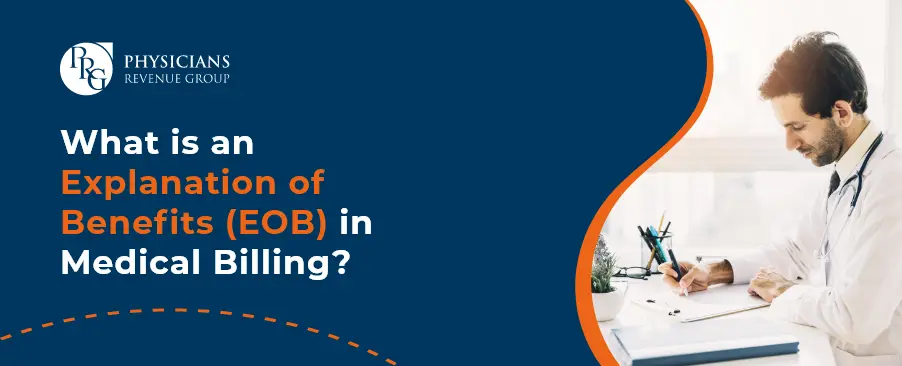
Email: info@prgmd.com | Call: +1 (630) 242-6474
Business hours: 9:00 to 5:00 | Monday to Friday
Email: info@prgmd.com | Call: +1 (630) 242-6474
Business hours: 9:00 to 5:00 | Monday to Friday

Table of Contents
ToggleIf you hold a health insurance plan – you may have heard about EOB.
Inside healthcare – EOB in medical billing stands for Explanation of Benefits. EOB serves as a document from your insurer after they process claims. It details the services and goods covered under your specific health insurance plan.
Why –patients often leave money on the table as they do not fully understand which services are covered by their insurance policies and which are not. Carefully reading EOBs helps patients learn how to get the most from their insurance benefits. Furthermore, it is equally essential to be able to read an EOB.
But first, let’s elaborate on:
Understanding the differences between professional and institutional claims is essential in comprehending the journey of an EOB in medical billing. Ideally, between the professional vs institutional claims;
Professional claims typically originate from individual healthcare providers like doctors, while institutional claims are associated with larger healthcare facilities such as hospitals. Recognizing these differences is essential for a seamless EOB process, ensuring accurate reimbursement for healthcare services.
In medical billing, provider credentialing is most important for healthcare professionals and institutions. This process involves verifying the qualifications and legitimacy of providers to participate in insurance networks. A well-established credentialing process is integral to the EOB’s effectiveness, as it ensures that billed services align with the approved credentials, facilitating a smooth reimbursement process. Understanding this connection is fundamental for healthcare practitioners.
Moving to the purpose of an EOB statement it typically includes key details like the following:
Date of service
The purpose behind this thorough breakdown is to clarify how the insurance payer processed the claim.
An EOB is vital in ensuring that the insurance payer covers the medical benefits outlined in a patient’s insurance plan. Clarification becomes essential because different healthcare insurance plans offer varied benefits for various procedures. This document safeguards against confusion, providing a comprehensive explanation of the covered benefits and assuring patients that their medical benefits align with the specifics of their health care insurance plan.
To sum up, the EOB in medical billing is a detailed guide, assisting patients through the particulars of their insurance coverage. It guarantees transparency at every step, ensuring patients can easily understand the process – from claim submission to payment details.
When it comes to EOBs in medical billing, understanding its key components is vital. While EOB statements may differ between insurance companies, they consistently include the same basic elements. These encompass:
An account summary
In these statements, you’ll also find information about the discount applied, referred to as an “adjustment,” an “allowed amount,” or sometimes, a “contracted agreement.” This highlights the difference between what the provider charges and what the insurance has paid.
Moreover, most EOBs (though not universally) feature a section detailing any copays, coinsurances, or deductibles applied. EOBs gives a comprehensive overview of the financial aspects of the healthcare service, ensuring transparency and clarity for both the patient and the other involved parties.
Regardless of the insurance provider, the core components of an EOB collectively paint a clear picture of the financial dynamics between the healthcare service provider and the insurance. This aids in understanding the particulars of medical billing, facilitating a smoother process for all parties involved.
Including an Explanation of Benefits (EOB) plays its role in cutting down on fraudulent practices related to overpaying or underpaying medical bills. By detailing the procedures, a patient has undergone safeguards against up-coding or under-coding errors.
If discrepancies arise between the final bill and the EOB, the patient has the right to question the hospital and the insurance payer. Simply put, the patient is accountable for paying the accurate amount owed to the hospital – neither more nor less.
EOB significantly contributes to maintaining the healthcare revenue cycle. Once the patient receives the EOB alongside their final bill, it is vital to cross-verify the covered benefits and promptly report any discrepancies. In the absence of differences, the patient must settle the due amount. This thorough process is essential for preventing financial losses and ensuring healthcare providers receive fair compensation for their services without any lapses.
In essence, the EOB statement in medical billing is vital in securing complete reimbursement while preventing insurance denial or fraudulent activities.
An EOB can help billing staff determine the following:
Moreover, the EOB in medical billing plays a vital role in identifying errors, such as an incorrect provider number, which can lead to delays or denials in processing claims. This highlights the importance of carefully analyzing EOBs in the medical billing process.
Share:
Categories
Recently Added

What is an ABN in medical billing?

What does a Clearinghouse do During Claims Submission?

What is EOR in Medical Billing?
We Would Love to Assist You!
We treat your data confidentially and don’t share any information with a third party.